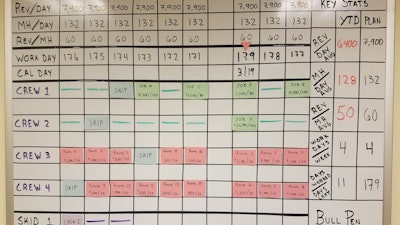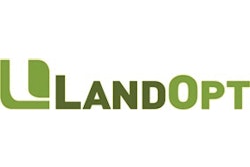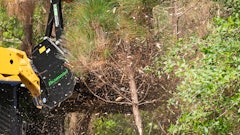
How do you measure success in your landscape contracting business? Maybe it’s seeing a specific number on the bottom line of the income statement. Maybe it’s customer testimonials and referrals. Or maybe it’s the assurance your team members feel confident and supported in their roles. Whichever way you choose to measure and define it, success can be an elusive concept. Wouldn’t it be nice to have a visual way to track success toward specific goals to ensure your business continues to run profitably and efficiently? There is a way; it’s called a schedule board.
As a scoreboard and efficiency tracker, a schedule board can take on many forms. One of the most effective is based on a chart developed by engineer and consultant Henry Gantt in the early 20th century. It relies on the assignment of and adherence to start and finish dates for both terminal elements—smaller parts of a larger task—and summary elements, which are composites of terminal elements.
The Gantt-based schedule board keeps teams and crews running smoothly by removing ambiguity related to job assignments, vehicle and equipment allocations, and expected revenue per job. It also clearly demonstrates which groups and individuals are completing tasks on time and within budget. While traditionally used to manage crew tracking, mobilization and job completion, the schedule board is an integral tool for measuring progress in four key areas: business management, operations, sales and marketing and human resources. Here’s how.
1. Business Management
Creating and diligently following an annual financial plan is one of the most impactful ways you can ensure your landscape contracting business runs cost-effectively over the long term. A comprehensive schedule board relies on the financial plan to determine how much revenue per man hour must be generated per job per day to stay on course toward plan goals while preserving available cash.
It also allows for careful budgeting and allocation of vehicles, equipment, tools and other resources required to complete each job. Including key statistics on the board, and keeping it in a highly visible area of the office or shop, gives team members tasked with procurement, payroll, and accounts receivable and payable an easy way to keep tabs on where the business stands in terms of crews, revenue and resources.
2. Operations
Non-billable time is one of the most common drains on cash flow in the landscape contracting business, especially in businesses that do not actively and proactively plan for recouping costs lost to non-revenue-generating activities. While necessary, non-billable events like crew mobilization, and jobsite setup and cleanup can eat away at available cash if they are not efficiently and carefully tracked.
Using the schedule board to clearly define parameters around non-billable time ensures critical revenue-generating time is maximized. Part and parcel of this maximization involves allocating skip days per week, depending on the season, for weather events, and repair and warranty work.
3. Sales and Marketing
Just as the bullpen in baseball is used as a holding area for relief pitchers, the bullpen on the schedule board serves as a holding area for sold jobs. Because backlog can be a drain on profits and available cash when not accounted and allotted for in advance, tasking your sales professionals with adding their sold agreements to the bullpen allows you and your team to see what work is on the horizon well before resources are allocated, and crews are scheduled and mobilized.
It also inspires a bit of friendly competition between and among members of your sales force, and provides a readily visible means of seeing the types of jobs typically sold to further refine marketing and prospecting initiatives.
4. Human Resources
Many landscape contracting businesses find themselves faced with labor and team shortages during peak seasons and times of abundant backlog. This often leads to reactive recruiting and, subsequently, high turnover that contributes to costly efforts to hire and train replacement team members. Using schedule board metrics to track and measure trends in sold jobs and crew requirements allows you to promptly and proactively address variables that impact staffing requirements throughout all 12 months of the calendar year.
The four key areas of your business—business management, operations, sales and marketing, and human resources—serve as pillars of support for the entire structure. Developing and implementing a schedule board is one way to help all four areas work in harmony to ensure a seamless, quality customer experience with minimal impact to the bottom line. Deceptively simple in design, the schedule board does the heavy lifting by sorting out complexities and streamlining processes, and lets you and your team do what you do best—provide top-quality solutions to discriminating customers.



















